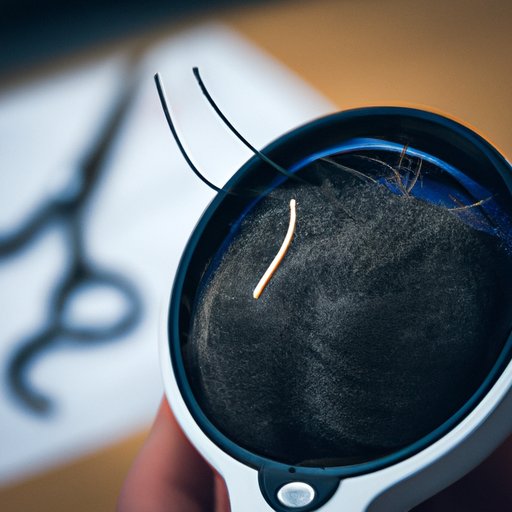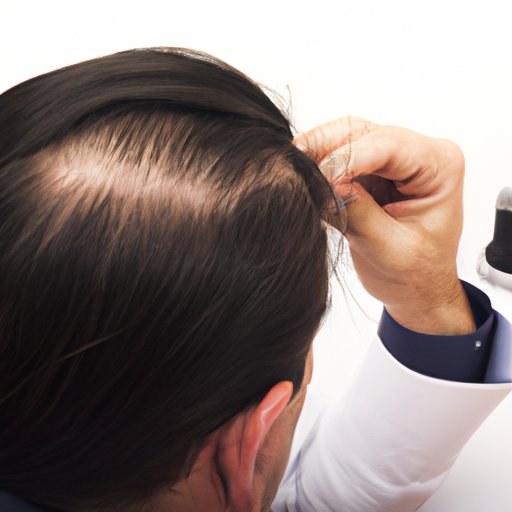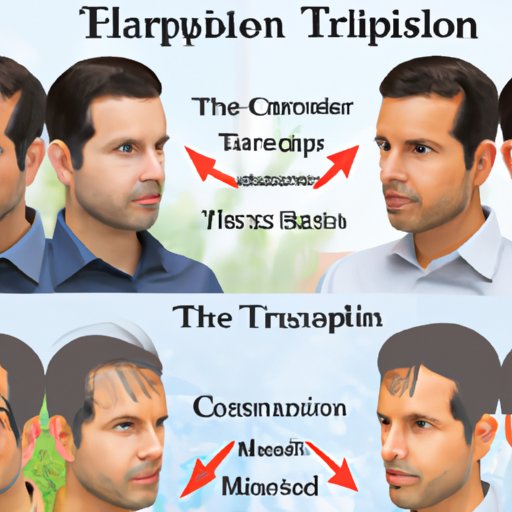Introduction
A hair transplant is a surgical procedure that moves hair from one part of the body to another. It is commonly used to treat hair loss conditions such as male pattern baldness or alopecia. This article will explore the basics of hair transplants, including what they are, how they work, and the different types of procedures available. We will also look at the potential benefits and risks associated with hair transplants as well as the cost involved. Finally, we will discuss potential alternatives to consider if a hair transplant is not an option.

Exploring the Basics of Hair Transplants: What They Are and How They Work
Hair transplantation is a surgical procedure that involves moving healthy hair follicles from a donor area on the body to a recipient area where there is thinning or balding. The goal of a hair transplant is to restore a natural-looking hairline and improve the appearance of the scalp. Hair transplants can be used to treat many different hair loss conditions, such as male pattern baldness, female pattern baldness, and alopecia.
There are two main types of hair transplant procedures: follicular unit transplant (FUT) and follicular unit extraction (FUE). In FUT, a strip of skin containing healthy hair follicles is removed from the donor area and then divided into individual grafts. These grafts are then placed in the recipient area. In FUE, individual hair follicles are extracted from the donor area and then transplanted into the recipient area. Both procedures can be performed using manual or robotic techniques.
A Step-by-Step Guide to Understanding Hair Transplant Procedures
Before undergoing a hair transplant, it’s important to understand the entire process from start to finish. Here’s a step-by-step guide to understanding how hair transplant procedures work:
Pre-Procedure Preparation
Before the procedure, the patient will meet with a hair transplant surgeon to discuss the details of the procedure and any potential risks. During this appointment, the doctor will evaluate the patient’s hair loss condition, determine the best donor site for harvesting hair follicles, and plan the placement of the grafts. The patient will also be given instructions on how to prepare for the procedure.
Procedure Steps
Once the patient is ready, the hair transplant procedure can begin. During the procedure, the following steps will be taken:
Harvesting Donor Hair
The first step of the procedure is to harvest donor hair from the donor site. For FUT, a strip of skin containing healthy hair follicles is removed. For FUE, individual hair follicles are extracted. The harvested hair follicles will then be prepared for transplantation.
Preparing the Recipient Site
Next, the surgeon will prepare the recipient site by making tiny incisions in the scalp where the grafts will be placed. The size and depth of the incisions will depend on the type of hair transplant being performed.
Placing Grafts
Once the recipient site has been prepared, the surgeon will carefully place the grafts into the incisions. The grafts will be placed in such a way that they mimic the patient’s natural hair pattern.
Post-Procedure Care
After the procedure, the patient will be given instructions on how to care for the transplanted hair. This includes avoiding certain activities, such as swimming and sunbathing, as well as avoiding certain products, such as hair dyes and styling products. The patient should follow these instructions closely to ensure the best results.

Investigating the Use of Hair Transplants for Hair Restoration
Hair transplants are most commonly used to treat hair loss conditions such as male pattern baldness and female pattern baldness. However, they can also be used to treat other conditions, such as alopecia. It’s important to have a clear understanding of the cause of the hair loss before considering a hair transplant.
Male pattern baldness is the most common cause of hair loss in men. It is caused by a combination of genetics and hormones. Female pattern baldness is similar to male pattern baldness but tends to affect women at a later age. Alopecia is an autoimmune disorder that can cause patchy or complete hair loss. Other conditions, such as burns, scars, and traction alopecia, can also be treated with hair transplants.

Comparing Different Types of Hair Transplant Techniques
When considering a hair transplant, it’s important to understand the different types of techniques available. Here’s a comparison of the most popular techniques:
Follicular Unit Transplant (FUT)
Follicular unit transplant (FUT) is the traditional method of hair transplantation. In this technique, a strip of skin containing healthy hair follicles is removed from the donor area and then divided into individual grafts. These grafts are then carefully placed into the recipient area. FUT is considered to be the most effective type of hair transplant.
Follicular Unit Extraction (FUE)
Follicular unit extraction (FUE) is a newer technique that involves extracting individual hair follicles from the donor area and then transplanting them into the recipient area. This technique is less invasive than FUT and can be used to treat smaller areas of hair loss. However, FUE typically requires more sessions than FUT and may not always yield the same results.
Robotic Hair Transplant
Robotic hair transplant is a newer technique that uses a robot to extract and implant the grafts. This technique is less invasive than FUT and FUE and can be used to treat larger areas of hair loss. However, robotic hair transplant is still relatively new and is not widely available.
Scalp Micro Pigmentation
Scalp micro pigmentation is a non-surgical procedure that uses tiny deposits of pigment to create the illusion of fuller, thicker hair. This procedure is best suited for those who want to conceal small areas of hair loss. While scalp micro pigmentation can help to improve the appearance of thinning hair, it cannot restore lost hair.
Examining the Benefits and Risks of Hair Transplants
Hair transplants can produce natural-looking results and can help to improve self-confidence. In addition, hair transplants are relatively safe and have few risks. However, it’s important to understand the potential benefits and risks before undergoing a hair transplant.
Benefits of Hair Transplants
The primary benefit of a hair transplant is that it can produce natural-looking results. In addition, a hair transplant can help to restore self-confidence and improve the overall quality of life. A hair transplant can also be used to treat many different hair loss conditions.
Risks of Hair Transplants
Although hair transplants are generally safe, there are some risks associated with the procedure. These include infection, scarring, and nerve damage. In rare cases, the transplanted hair may not take or the transplants may be rejected by the body. It’s important to understand the potential risks before undergoing a hair transplant.
Analyzing the Cost of Hair Transplants and Potential Alternatives
Hair transplants can be expensive and the cost can vary depending on the type of procedure, the size of the area being treated, and the number of grafts needed. In general, the cost of a hair transplant ranges from $4,000 to $15,000. It’s important to speak with a doctor to get an accurate estimate of the cost.
If a hair transplant is out of your budget, there are other options to consider. For example, medications such as minoxidil and finasteride can help to slow down hair loss and may even help to regrow some hair. Wigs and hairpieces can also help to conceal hair loss. It’s important to research all of your options before deciding which is best for you.
Conclusion
Hair transplants are a safe and effective way to treat hair loss conditions such as male pattern baldness and alopecia. There are several different types of hair transplant techniques, each with its own benefits and risks. It’s important to understand the potential benefits and risks of hair transplants before deciding if it’s right for you. In addition, it’s important to understand the cost of the procedure and potential alternatives. With the right information and preparation, a hair transplant can be a great way to restore a natural-looking head of hair.
Summary of Key Points
In summary, a hair transplant is a surgical procedure that moves hair from one part of the body to another. There are two main types of hair transplant procedures: FUT and FUE. Hair transplants can be used to treat many different hair loss conditions, such as male pattern baldness and alopecia. The cost of a hair transplant can range from $4,000 to $15,000. It’s important to understand the potential benefits and risks of hair transplants before deciding if it’s right for you.
Final Thoughts
Hair transplants can be a great way to restore a natural-looking head of hair. With the right information and preparation, a hair transplant can be a safe and effective solution for many people. It’s important to do your research and speak with a doctor to determine if a hair transplant is right for you.
(Note: Is this article not meeting your expectations? Do you have knowledge or insights to share? Unlock new opportunities and expand your reach by joining our authors team. Click Registration to join us and share your expertise with our readers.)
